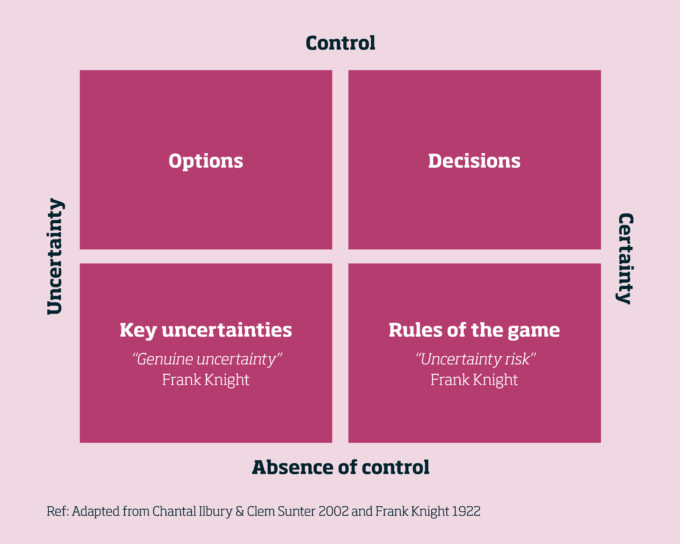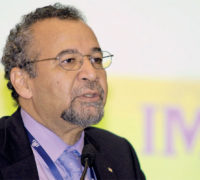
The end of corporate passivity: Why business leaders must shape geopolitics, not just react to it
To thrive in a fragmented world, business leaders must stop being passive spectators and start actively shaping geopolitics, urges IMD’s Arturo Bris...

by Hischam El-Agamy Published January 26, 2024 in Strategy • 7 min read
During South Africa’s transition from apartheid to a multiracial government in the 1990s, uncertainty abounded. Looking back some three decades later, we can see how scenario planning played a positive role in bringing stakeholders together to tackle the unknown.
Today, in many parts of the world, we find ourselves again facing a large degree of uncertainty. For example, the current wars in Ukraine and Gaza have laid bare an urgent need to factor uncertainty into our strategic planning – something scenario planning is well equipped to do. I urge us to get back to it.
To be sure, uncertainties are broached in organizations’ strategy rooms. However, a common pitfall is that we conduct just a single exercise and then set whatever is learned from it on the shelf.
Ignoring uncertainties renders organizations and society at large vulnerable to incoming threats. At the same time, non-obvious opportunities can pass us by – leaving us to miss out on their potentially valuable benefits.
In late 2019, before 2020’s pandemic was yet evident, end-of-year executive committee and board meetings certainly discussed their updated strategic plans for 2020 and beyond. Mapping out the next two to three years, strategy teams worked hard to feed their planning processes with sophisticated analyses of the previous year’s facts and figures. Projected prices, market conditions, customers, and competitors were all surely discussed.
And yet, even if looming uncertainty was addressed, it was often on the strategy report’s final page as a brief mention. Shouldn’t we be better prepared now than we were then?
Over 100 years ago, in 1921, Frank H Knight, the idiosyncratic economist at the University of Chicago, wrote a great book called Risk, Uncertainty and Profit. In it, Knight distinguished between two types of uncertainty:
Knight’s critical point is this: genuine uncertainty creates opportunities for profit that are not eliminated by perfect competition. In other words, if we want to innovate successfully in business, we must not only deal with uncertainty but seek it out.
In their 2001 bestselling book, Mind of a Fox, South Africa-based authors Chantell Ilbury and Clem Sunter look at how we, as human beings, think about events and uncertainty. They offer a useful matrix with two continuums: (1) certainty/uncertainty and (2) control/absence of control.

At the bottom of their matrix, two areas map to Knight’s earlier thinking on uncertainty. Working from right to left:
At the top of this matrix, where there is more control, is where decision-makers naturally tend to be more comfortable:
Modern scenario planning is generally attributed to the American futurist and game theorist Herman Kahn, who introduced the tool to the US military in the 1950s while consulting for the Rand Corporation.
In the early 1970s, oil executive Pierre Wack helped introduce a form of scenario planning to private-sector strategy in his job at Royal Dutch Shell. Wack’s work was said to help the oil giant anticipate two oil shocks in a decade. He described scenario planning as “a discipline for encouraging creative and entrepreneurial thinking and action… in contexts of change, complexity, and uncertainty,” as Thomas J Chermack wrote in Foundations of Scenario Planning: The Story of Pierre Wack.
In the early 1990s, during South Africa’s transition from apartheid, scenario planning also played a significant role. The Mont Fleur Scenario exercise to imagine South Africa 10 years into the future was a notable example of how a diverse group with very different political beliefs could be brought together to constructively explore ways to transform the nation.
In business, a basic exercise is to first identify the driving forces shaping the future, then map them based on their potential impact and degree of uncertainty involved. That is to say, it’s useful to rank these drivers based on their potential impact on business as well as their degree of uncertainty (with high uncertainty ranking higher on your list).
Successful scenario planning will be built around the forces that have the most potential for high impact at the same time as they are highly uncertain. These are the forces you want to monitor closely over time to foresee future scenarios and analyze them. Select just two of them to continue with our basic exercise.

These two drivers that you have selected can then be displayed on an axis, with low and high values for each, to create four possible future scenarios. Develop a narrative (story) for each, imagining various plausible futures, revising mental models of the present based on those futures, and using new models to either reinforce or change business strategies to better prepare for what might come to pass.
Amid swift transformations driven by geopolitical events, macro- and microeconomic forces, societal shifts, environmental changes, and the undeniable pace of technological advancements, organizations should (re)turn to scenario planning as a strategic tool. This approach can help us innovate successfully ahead of whatever happens next – and prepare for the future today.
Scenario planning: how to navigate multiple crises – Peter Schwartz, author of the highly influential book The Art of the Long View, explains to David Bach what needs to be done – and why he remains optimistic about the future.

IMD Executive Director, Middle East, Africa and Turkey
As Executive Director of IMD, Hischam El Agamy is responsible for IMD’s activities in Africa, the Middle East, and South-Central Asia, where he teaches and leads development programs. El Agamy’s expertise and teaching experience include scenario planning, business transformation, family business transformation, public-private partnership, and stakeholder engagement. He teaches regularly in IMD custom programs and has taught several IMD open programs, including its EMBA and MBA programs.
For over 14 years, El Agamy has occupied various international functions in seven European countries as part of a long career with major Swiss multinational corporations in Zürich. During these years, he has driven a number of business transformation initiatives in several European countries.
He has contributed to several advisory assignments for governments in the Gulf region and in the area of competitiveness and human capital development for the government of South Africa.
El Agamy obtained two master’s degrees in applied science from the University of Fribourg and Lausanne in Switzerland. He received his Doctorate from the University of Pierre & Marie Curie in Paris.

June 23, 2025 • by Arturo Bris in Governance
To thrive in a fragmented world, business leaders must stop being passive spectators and start actively shaping geopolitics, urges IMD’s Arturo Bris...

May 19, 2025 • by Peter Voser in Governance
Board members have a central role to play in helping organizations steer a safe path in a polarized and skeptical world....
 Audio available
Audio available
April 28, 2025 • by Jordi Gual in Governance
Companies pursuing ESG goals increasingly face a backlash from shareholders who fear a drop in financial performance. Changes to corporate governance may be needed to restore trust on both sides of the...
 Audio available
Audio available
March 27, 2025 • by Jennifer Jordan, Alexander Fleischmann in Governance
Take our quiz to see if you're well-placed to implement new European rules on boardroom equality....
 Audio available
Audio availableExplore first person business intelligence from top minds curated for a global executive audience